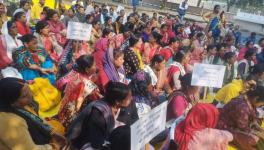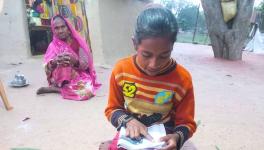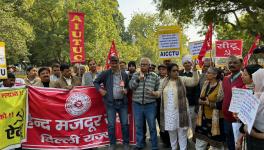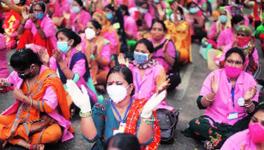Will Most Marginalised People of Banaras pay Price of its Beautification?
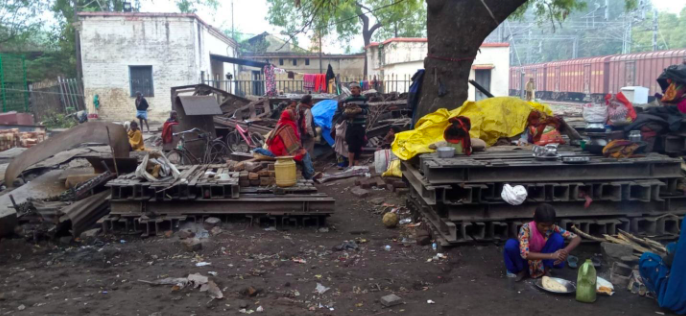
Families living at the construction site near Kashi station
The Kashi railway station, near the Rajghat bridge in Banaras, seems to always be crowded. Passengers constantly commute in and out of the city or spend time around the station. A few months ago, one could notice homeless families from dalit communities living on the empty land near the station. Many also live on the sidewalks, with only a thin plastic sheet strung on the street lamp posts to cover their heads.
These people are primarily engaged in labour; a few also beg for money or food around the station. Around 30 to 40 families used to live there. At present, most of them seem to have vanished.
Dharmu, a labourer who lives there, sits with his wife and three kids and prepares tea for everyone. His family is one of the few left there. “Bade saheb has said that this place will be fully under construction soon,” he says, adding, “A part of it already is. You can see the JCB there.”
Dharmu works in this space as well. The government has taken it up to build what the locals suspect to be a parking lot for the station. Measurements of the empty land had been taken a year ago, and now the work is in progress. Surrounded by rubble and huge stones, Dharmu has been living here for many years, but now, he is worried about a place for his family to live because of the new construction work.
“We have been working at this place, and we have put up a request with the officials to do something for us. We have been living here for years; where will we go next?” Dharmu laments.
Such constructions are part of 'the beautification of Banaras'. Banaras or Varanasi, the constituency of Prime Minister Narendra Modi, has been given special attention for beautification, and the ghats are one of the city's main features. A total of 84 ghats have seen improvements, including renovation of staircases, a museum at Rajendra Prasad ghat, and general cleanliness. Last year, Khidkiya ghat, next to Rajghat, was renovated to the highest degree. It now has a parking lot, a CNG-filling station, an open-air theatre, and many other facilities. Before the beautification, the area around the ghat was housed by several slums with people living in mud houses. All of them were asked to move out, and several were rehabilitated to Bajardihan under the Pradhan Mantri Awas Yojana (PMAY) in Banaras. But many were left out to fend for themselves and entered other slums in the city.
Similarly, the officials had reassured Dharmu that he and his family would get a small home under PMAY. His wife, Madhu Sonkar, attempted to avail a house under this scheme. "I have applied for it using my Aadhaar card. But when I went to Kachahari (the office), the official over there told me that a bank account was required," she explains.
After a lot of paperwork and legwork, Madhu could finally open a bank account. Later, when she got it done, the officials asked her for a sum of 10,000 rupees to proceed and avail a house under the PMAY. "How will we get such a big amount? I don't think the government will give us any house," Madhu says, visibly dismayed. Now, she does not make an effort to painstakingly visit the officials and appeal for a house.
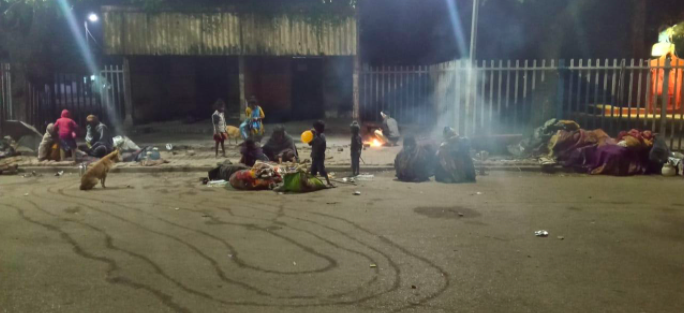
Few families living on the sidewalk at night
The families living without a roof over their heads around Kashi station are generally from the outskirts of Banaras. Many have been living here for 10 to 15 years. “Governments come and go; they tell us they will give us a house. But we have not seen that happening yet,” said Sukhdev, another labourer living in the area, while speaking to Newsclick. Some of the castes that live here are doms, mallahs, musahars, and chamars -- all from the most downtrodden sections.
Migrant workers from Bihar and Jharkhand also stay around here and engage in different types of work. Children either beg around the station or work at the police station nearby, taking up odd cleaning jobs. Teenagers and adults who are able-bodied work in the city as labourers, trying to aid their already precarious conditions. Most families here do not have an Aadhaar card or Voter ID and are illiterate. Hence, they have no way to avail benefits provided by the government as they do not fall under the set citizenship criteria. The COVID-19 vaccinations have been skipped too by many for the same reasons. These conditions have been aggravated by the inevitable reconstruction of the Kashi station area, while rehabilitation of these people remains uncertain.
Another group of people who populate the area and are a large part of the tourist economy at the ghats are the hawkers and small shopkeepers who sell tea and snacks. Around 3,000 in number, they are omnipresent at the ghats, serving all kinds of people, locals or tourists. Many of them are migrants from other states, such as Bihar, and see the whole beautification stride of the ghats with dismay.
Bihari, a hawker selling tea at one of the ghats, says that he is afraid that they will not be allowed to do business at the ghats. “Who knows what changes will happen to the ghats. Already when VIPs come, we are forced to move out of the ghats, and it affects our income. Now the whole corridor is becoming VIP,” he says, pointing to the burgeoning Kashi Vishwanath corridor that connects many ghats to the famous Kashi Vishwanath temple. Usually, the area around the corridor has some VIPs visiting one day or the other. Carts and small hawkers are then kicked out of these premises by the police or face severe penalties if they continue selling.
Vinay Pratap from Uttar Pradesh’s Amethi has been selling tea by roaming the ghats for the past 20 years. He tells Newsclick, “If the ghats were to be populated by hi-fi restaurants, what would small tea-sellers like us do?” But he also pointed out a jarring social conflict that all small hawkers at the ghats go through. The mallah caste community, a dominant community of boatmen, allegedly exploit the tea sellers. “They trouble us; they eat and drink our items and do not pay. Many harass us while intoxicated,” Vinay says, adding, “if we ask for our money, they quarrel with us.” This is of daily occurrence because the people from the mallah community consider these hawkers “outsiders” and say that they steal away business from local sellers.
Many migrant labourers sleep at railway stations like the one in Kashi at night, as they cannot afford a place to live. Vinay, who also lives like that, says, “The government will kick the mallahs out as well if they renovate the ghats." This is another precarious condition facing the mallah community who own houses and live near the ghats. It is rumoured that the onslaught of beautification will soon engulf them as well. The beautification projects of the ghats and that of the whole city are putting the lives and livelihood of the most marginalised people of the city in jeopardy.
The writers are freelance journalists.
Get the latest reports & analysis with people's perspective on Protests, movements & deep analytical videos, discussions of the current affairs in your Telegram app. Subscribe to NewsClick's Telegram channel & get Real-Time updates on stories, as they get published on our website.









